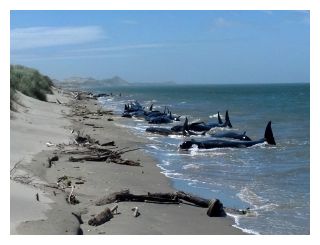
© FairfaxA pod of 28 whales stranded at Farewell Spit, Golden Bay.
A pod of 28 pilot whales stranded on Farewell Spit in Golden Bay are to be shot by DOC staff.
The Department of Conservation told
ONE News that it was first alerted about a beaching at 9am, and when volunteers arrived to rescue a second whale, they discovered 28 stranded on the beach.
Twelve whales died in the first hour and DOC staff said the unusually high death rate and the fact that the next high tide is not until tomorrow lunch time forced them to make the decision, along with local iwi and Project Jonah volunteers, to euthanise the rest of the stranded whales.
Staff will use a high-calibre rifle to euthanise the whales and this process will start in the next hour.
"It's really sad and not a situation we take lightly but anything else is inhumane and would prolong their suffering," DOC biodiversity manager Hans Stoffregen said.
"They don't look that flash so putting them all through another two days of this is inhumane."